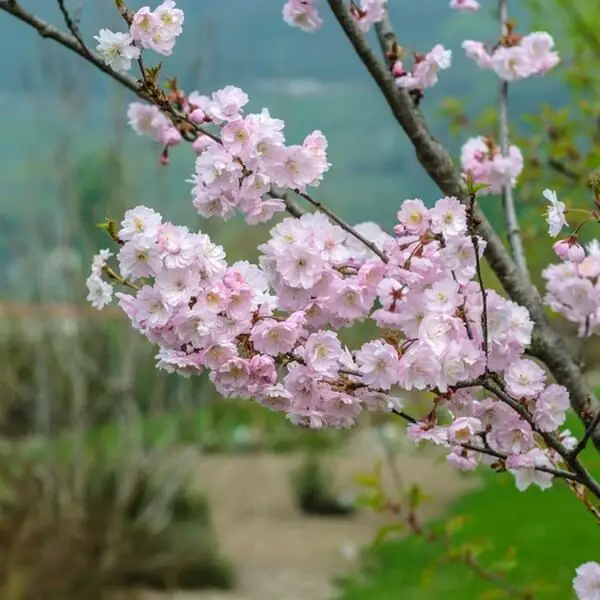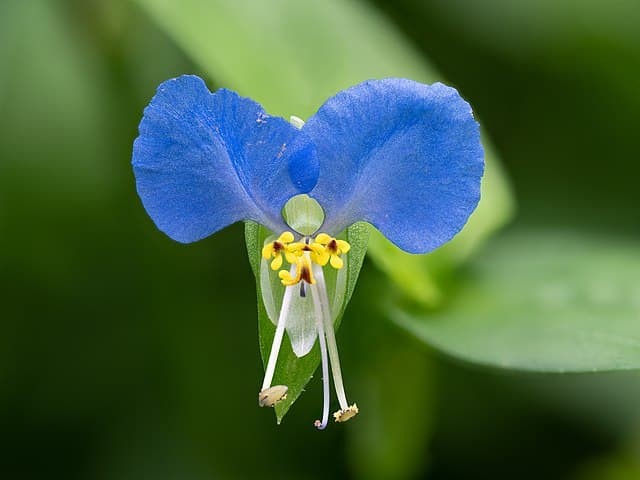18+ Types Of Ash Trees: Leaves, Bark, Identification, Characteristics
If you’re looking for a versatile and attractive addition to your landscape, consider planting an ash tree. With numerous species to choose from, each with its unique characteristics, it’s essential to understand what makes an ash tree special. This article will delve into the world of ash trees, exploring their types, identification features, and care requirements. You’ll also learn about the benefits and potential drawbacks of having an ash tree in your yard.
Ash trees are characterized by their compound leaves, distinctive bark patterns, and ability to thrive in various environments. From the majestic white ash to the rare pumpkin ash, there’s a type of ash tree suitable for every landscape. Whether you’re looking for a fast-growing tree or one that can tolerate urban conditions, an ash tree is worth considering. Some popular species include the black ash, blue ash, California ash, and European ash, each with its unique features and growth habits.
You’ll also discover the differences between these species and how to identify them. In addition to learning about the types of ash trees, you’ll find information on their care requirements, including tips on watering, pruning, and fertilizing. With proper care, an ash tree can thrive for many years and provide shade, beauty, and a sense of serenity to your outdoor space.
What is an ash tree?
A member of the genus Fraxinus within the olive family, ash trees are a diverse group that also includes lilacs, jasmine, and privet. Native to North America, Europe, and Asia, there are approximately 60 species of ash trees that thrive in these regions. Among them is the white ash, a common sight in North America. This species can reach impressive heights of up to 100 feet and boasts a lifespan of 60 to 80 years.
The wood of the ash tree is renowned for its remarkable strength and hardness, making it an ideal material for crafting items like furniture, flooring, and even baseball bats.
Facts about ash trees.
Ash trees, known for their striking foliage and robust growth, exhibit a unique set of characteristics that set them apart from other tree species. As deciduous trees, they shed their leaves annually, typically in the fall. Their towering heights can reach up to 100 feet, with opposite branching patterns, where branches emerge in pairs from the trunk. The compound leaves are a defining feature, comprising multiple smaller leaflets ranging from five to 13, depending on the species.
The ash tree family, which includes lilacs, jasmine, and forsythia, is part of the olive family. Its wood is renowned for its exceptional strength and hardness, making it a sought-after material for furniture, flooring, and even baseball bats due to its resistance to splitting. The versatility of ash tree wood has contributed to its widespread use across various industries.
Ash trees are native to North America, Europe, and Asia, with three distinct species found in North America: the white ash (Fraxinus americana), green ash (Fraxinus pennsylvanica), and black ash (Fraxinus nigra). Unfortunately, all species of ash tree are currently threatened by the emerald ash borer, an invasive beetle that feeds on the bark of ash trees, causing them to perish.
Furthermore, they are susceptible to fungal diseases such as ash dieback and sudden oak death, which pose additional risks to their survival.
Ash tree meaning.
The symbolism surrounding the ash tree is deeply rooted in its association with strength, stability, and growth. It’s often seen as a beacon of new beginnings, representing the capacity to adapt and thrive in the face of adversity. In folklore, the ash tree is revered for its healing properties and is commonly used in traditional medicine. Additionally, it’s believed to possess protective qualities against malevolent forces, offering a sense of security and peace.
The wood itself is remarkably resilient, making it an excellent choice for crafting furniture and other woodworking projects. Its strength and stability also render it an attractive option for landscaping and construction endeavors.
How to identify an ash tree.
The ash tree, a ubiquitous species across North America, can be identified through several distinct characteristics: its leaves, bark, and overall shape. One key identifier is the leaf structure itself – opposite, compound leaves with serrated edges, featuring oval-shaped leaflets with pointed tips. The foliage is typically dark green in hue, transitioning to shades of yellow, brown, or purple as the seasons change. Another method for distinguishing an ash tree is by examining its bark.
Typically, this species boasts smooth, grayish-brown bark that may also exhibit a diamond-shaped pattern. Lastly, the overall shape of the tree itself can be used for identification purposes. Ash trees tend to grow tall with straight trunks and evenly distributed branches, culminating in a rounded or flat crown.
Ash tree leaves.
The distinctive appearance of ash tree leaves is characterized by their compound structure, comprising multiple leaflets that can vary in shape depending on the specific species. Oval or oblong in shape, these leaflets typically exhibit a green hue, although some varieties may display yellowish or brownish tones.
As deciduous trees, ashes shed their leaves annually, with the fall foliage often featuring a kaleidoscope of colors as the leaves transition from green to shades of yellow, red, and brown before falling to the ground.
Ash tree height.
While the average height range for an ash tree is typically between 20 to 30 feet, some species can stretch up to an impressive 100 feet tall. In fact, the tallest recorded ash tree stood at a remarkable 111 feet in Ohio, showcasing the incredible potential of these trees.
When it comes to growth rate, ash trees are generally considered relatively fast-growing, with some varieties adding as much as two to three feet per year, making them a popular choice for landscaping and reforestation efforts.
Ash tree bark.
The bark of an ash tree undergoes a significant transformation as it matures, showcasing its unique characteristics. In its early stages, the bark appears smooth and gray. However, as the tree grows older, the bark develops into a rough and scaly texture with deep fissures, giving it a rugged appearance. Beneath this outer layer, the inner bark is typically white to light green in color.
Another distinctive feature of ash trees is their opposite branching pattern, where branches emerge in pairs on either side of the trunk.
Ash tree seeds.
The ash tree’s reproductive unit, known as the seed or samara, is a tiny, hard, and dry fruit with two wings. This unique design enables the seed to spin and fall to the ground as it disperses. Interestingly, the samara is surrounded by a thin, papery wing that facilitates wind dispersal, allowing the ash tree’s seeds to travel further. Native to North America and Europe, the ash tree has been an integral part of these regions’ ecosystems for centuries.
Ash tree flowers.
Ash trees, being deciduous, undergo a seasonal change where they shed their leaves annually. A characteristic feature of these trees is the small, cluster-bearing flowers that lack distinct petals. Typically, the flowers display a subtle greenish-white or purplish hue, relying on wind for pollination.
Ash tree uses.
Native to North America, the ash tree is characterized by its distinctive grayish-white coating, earned from the powdery substance that covers its leaves and branches. This deciduous tree has been utilized extensively throughout history, boasting a range of practical applications. Its durable wood makes it an ideal choice for furniture and flooring, while the bark is valued for its medicinal properties.
For centuries, Native Americans have leveraged the ash tree’s versatility, employing its wood to craft bows and arrows, canoes, and other essential tools. The bark, too, has been harnessed to produce a variety of medicines. Beyond its utilitarian appeal, the ash tree plays a vital role in supporting local ecosystems. Its leaves serve as a prime source of sustenance for deer, rabbits, and other browsing animals.
Moreover, the trees provide habitats for birds and small creatures like squirrels, underscoring their importance within the natural world.
Types of ash trees.
The diverse world of ash trees is comprised of various species, each boasting distinct features that set them apart from one another. From their physical appearance to their growth habits, the differences between these trees are notable and worthy of exploration.
Black Ash (Fraxinus nigra).
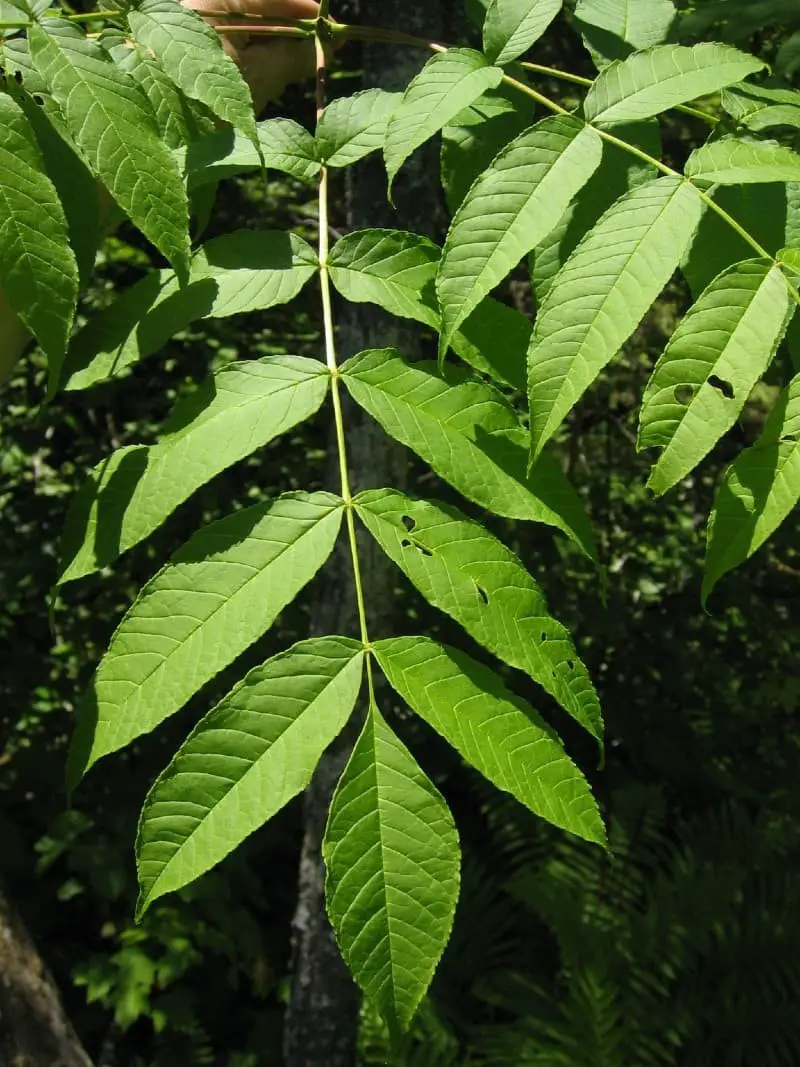
In North America, the black ash (Fraxinus nigra) is a prominent deciduous tree species found in eastern Canada and the northeastern United States. Reaching heights of 20-35 meters (66-115 feet), its trunk typically measures 60-90 centimeters (24-35 inches) in diameter, with dark brown to black bark featuring deep fissures. The pinnate leaves, spanning 20-40 centimeters (12-16 inches) in length, boast seven to thirteen leaflets each.
As a vital component of forests, the black ash often coexists with other hardwoods like maples and oaks. Its significance extends beyond its ecological role, as it provides sustenance and shelter for various wildlife species. The tree’s wood is notable for its hardness and heaviness, with a density ranging from 660 to 850 kilograms per cubic meter (33). This versatile material is utilized in the production of furniture, flooring, and tool handles, among other applications.
In addition to its ecological importance, the black ash tree plays a significant role in human society, offering food and shelter for many animals while also serving as a valuable resource for various purposes.
Blue Ash (Fraxinus quadrangulata).
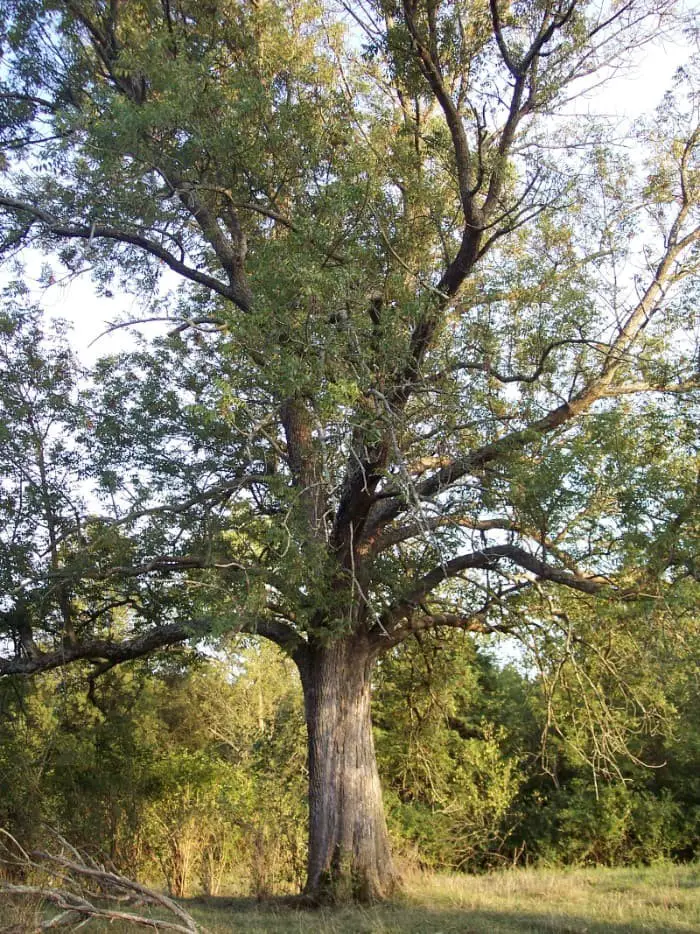
The blue ash tree (Fraxinus quadrangulata), also known as the swamp ash, is a deciduous native to North America. This species grows up to 50-60 feet tall with a spread of 30-40 feet, featuring a rounded crown and spreading branches. Its brown, ovoid, and pointed buds add visual interest to its appearance. In terms of growing conditions, the blue ash tree thrives in moist, well-drained soils that receive full sun to partial shade.
It exhibits remarkable adaptability, tolerating a wide range of soil types, including clay, sand, and loam, as well as drought and salt. Unfortunately, the blue ash tree is susceptible to several diseases, including ash yellows, verticillium wilt, anthracnose, and canker, which can significantly impact its health. Additionally, it faces threats from insect pests like borers, scale, caterpillars, and aphids.
Despite these challenges, the blue ash tree remains a popular choice for landscaping purposes, including serving as shade trees, street trees, and reforestation projects. Its versatility also makes it suitable for various industrial applications, such as lumber, veneer, tool handles, baseball bats, and fuel wood. In terms of physical characteristics, the bark is grayish-brown and smooth with small lenticels, while the twigs are slender and gray- brown.
The leaves are opposite, pinnately compound with five to seven leaflets that are ovate to lanceolate, sharply serrate, and dark green above with a paler green below. They turn yellow in the fall. The blue ash tree’s flowers appear in April or May as terminal panicles of greenish-yellow blooms before the leaves emerge. Its fruit is a two-seeded samara that is obovate, winged, and matures in September or October.
California Ash (Fraxinus dipetala).
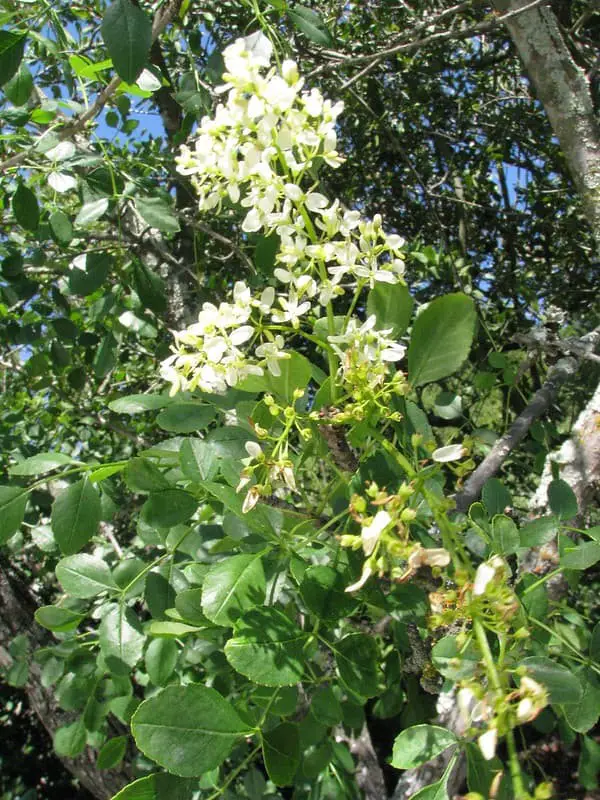
The California ash tree stands out as a unique specimen due to its exclusive status as the only native ash species in California. This deciduous tree thrives between 20-35 feet tall, boasting a slender trunk and compound leaves with multiple leaflets that turn yellow before dropping off in fall. A notable characteristic of the California ash is its dioecious nature, featuring separate male and female trees that produce keys (seeds) and pollen, respectively.
These versatile trees inhabit riparian areas, mixed evergreen forests, chaparral, and even urban spaces, where they’re often employed as street trees or in landscaping. As a keystone species in riparian ecosystems, the California ash plays a vital role in maintaining ecological balance. Its significance extends to animal habitats as well, providing sustenance and shelter for various creatures like birds, squirrels, and deer.
Humans also rely on this tree; its wood is utilized for furniture, flooring, cabinetry, baseball bats, and other sports equipment. The tree’s bark is smooth and light gray, thin and prone to damage. Its leaves are simple, opposite, and toothed, measuring 5-10 centimeters in length with a short leaf stalk. In late April or early May, the California ash produces small greenish-white flowers borne in clusters of ten to fifteen. The fruit takes the form of winged samaras, approximately 2.
5-3 cm long with a single seed, ripening in September or October and dispersing via wind.
Carolina Ash (Fraxinus caroliniana).

The Carolina ash is a medium-sized tree that thrives in the southeastern United States, where it can be found in states such as North Carolina, South Carolina, Georgia, and Florida. This ornamental plant is highly sought after for its landscaping potential in public parks, gardens, and residential yards. As a member of the olive family, the Carolina ash shares similarities with other trees like white ash and green ash.
Its scientific name, Fraxinus caroliana, literally means ‘of Carolina,’ while its common name stems from its geographical range. A deciduous tree, the Carolina ash sheds its leaves during winter months, typically living between 20 to 30 years but occasionally reaching ages of up to 100 years. When grown in full sun and moist, well-drained soils, the Carolina ash is relatively tolerant of drought and salt, making it a popular choice for streetscapes as well.
However, the tree can be susceptible to diseases like leaf spot, anthracnose, and twig blight. The Carolina ash’s bark is smooth and gray, with small lenticels, while its twigs are slender and green before turning brown in autumn. Its leaves are dark green, oval-shaped, and serrated-edged, transitioning to yellow before shedding in fall. In springtime, the tree produces small, greenish-white flowers that give way to winged fruits approximately an inch long.
European Ash (Fraxinus excelsior).

The European ash (Fraxinus excelsior), commonly referred to as the common ash, is a deciduous tree that belongs to the Oleaceae family. Native to Europe, Asia Minor, and North Africa, this widespread species can be found thriving in its natural habitat. In terms of physical characteristics, the European ash typically reaches heights between 20-30 meters (66-98 feet), with trunks that range from 0.50 to 0.90 meters (19-35 inches) in diameter.
The bark is smooth and pale grey, while the branches are sturdy and adorned with small buds. Leaf-wise, the European ash boasts pinnate leaves with a length of 15-25 centimeters (59-98 inches), featuring lanceolate leaflets with serrated margins. Small flowers borne in clusters give way to winged seeds, also known as ‘keys’. As a popularly cultivated tree, numerous cultivars are available for use as street trees or in parks and gardens.
The wood of the European ash is renowned for its heaviness, hardness, and strength, making it an ideal material for construction, furniture-making, and other applications. In addition to its economic value, the European ash plays a vital ecological role, serving as a crucial food source for various animals, including birds, rodents, and insects.
Furthermore, the leaves are used as fodder for livestock, while the wood is utilized in industries such as construction, furniture-making, and paper production.
Green Ash (Fraxinus pennsylvanica).
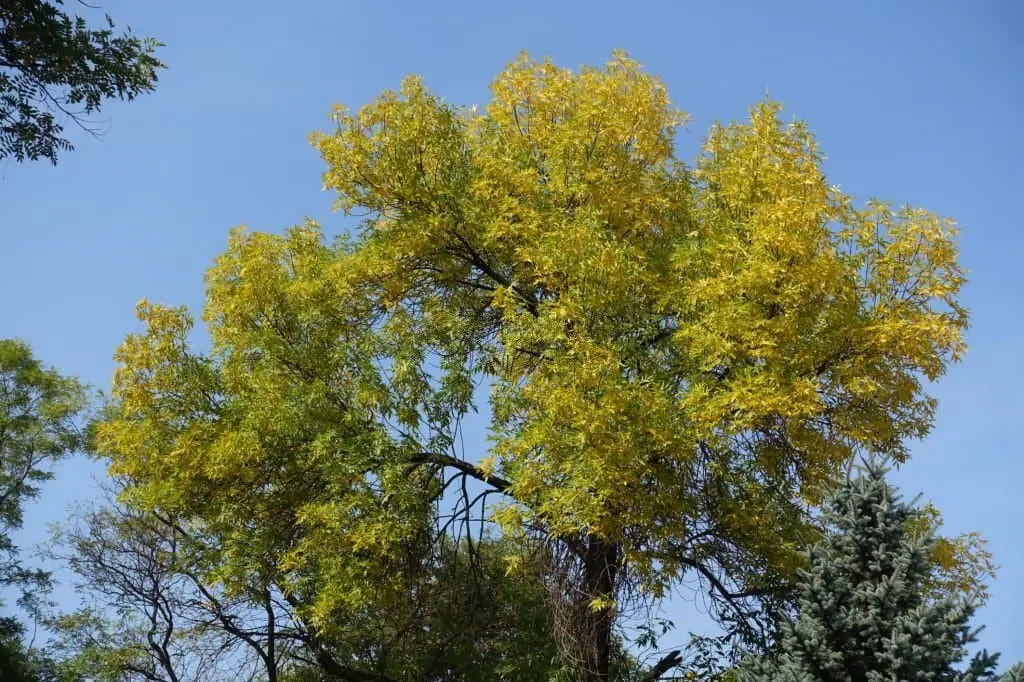
The green ash tree, native to North America, boasts a medium size with a height ranging from 40-60 feet and a spread of approximately 30-40 feet. Its leaves are notable for their unique opposite, pinnately compound arrangement, featuring seven to nine leaflets. The tree’s flowers are small and greenish-white in color, borne in clusters that add charm to its overall appearance. The fruit, in the form of winged seeds, is also clustered, a characteristic shared with other species within this genus.
Aside from being an essential source of wood for various industries such as furniture making, lumber production, and paper manufacturing, the green ash tree has practical uses as a shade tree and ornamental addition to landscapes. However, it is not immune to the challenges posed by diseases and pests. The emerald ash borer, specifically, has had a significant impact on North American populations of ash trees, including those of the green ash species.
Gregg’s Ash (Fraxinus greggii).

In the southwestern United States and northern Mexico, a unique species of ash tree thrives – the Gregg’s ash. This tree was named after John Gregg, a pioneering botanist from the 19th century who made significant contributions to our understanding of plant life. The Gregg’s ash can reach impressive heights of up to 30 feet, with dark green leaves measuring between six and eight inches in length.
In terms of its reproductive cycle, the tree produces small, greenish-white flowers that eventually ripen into dark purple fruits. As a vital component of its ecosystem, the Gregg’s ash serves as a crucial food source for local wildlife, including birds and mammals. Furthermore, the tree is also prized for its durable wood, which is used in various lumber and wood product applications.
Himalayan ash (Fraxinus griffithii).

The Himalayan ash tree, a native species to the majestic Himalayan Mountains, stands tall at heights of 30-40 meters with a sturdy trunk diameter ranging from 60-90 cm. Its leaves are uniquely pinnate, comprising 20-30 leaflets that fan out in a distinctive pattern. The flowers of this magnificent tree emerge in panicles, while its fruits take the form of winged seeds, allowing for efficient dispersal.
Notably, the Himalayan ash tree is a vital source of timber within the region, with its wood being renowned for its hardness, strength, and durability. This prized resource is harnessed to craft furniture, flooring, doors, windows, and other wooden products that are in high demand. Additionally, the tree’s wood serves as a reliable fuelwood and charcoal production material.
The Himalayan ash tree thrives at elevations of 1500-3000 meters within its native habitat, growing abundantly in forests, on slopes, and in ravines. Preferring well-drained soils and full sun exposure, this remarkable tree has adapted to its environment with ease.
Japanese ash (Fraxinus lanuginosa).
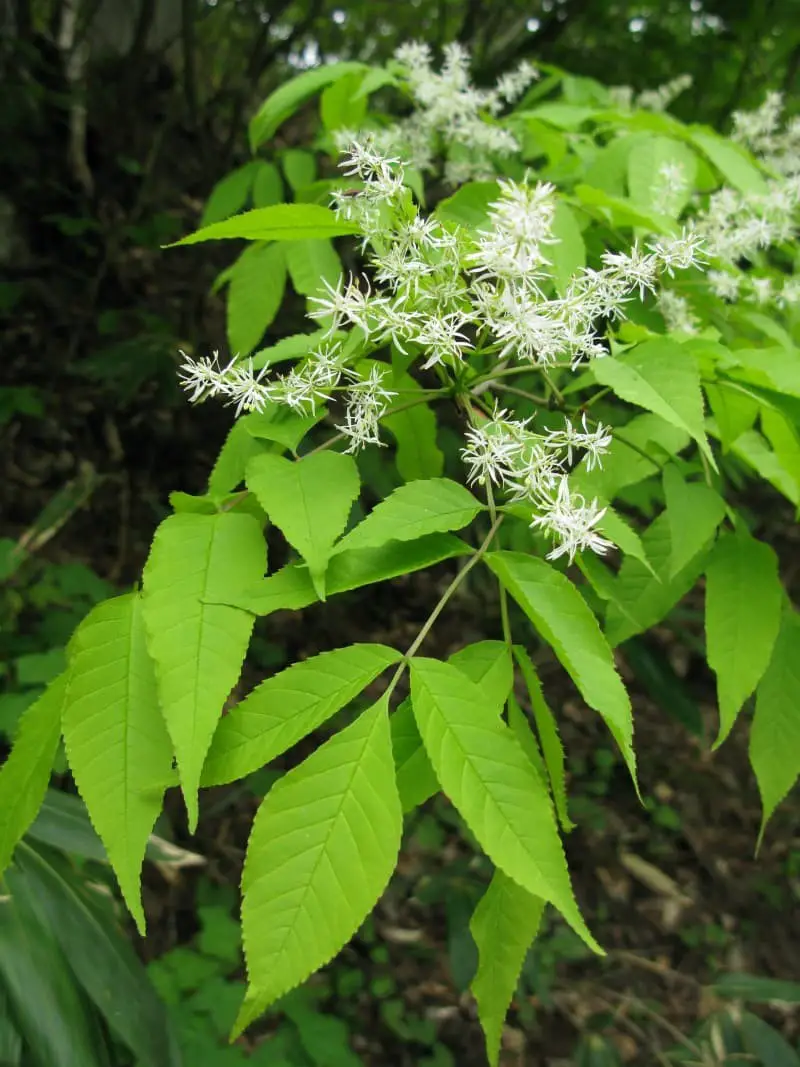
Japanese ash trees can reach heights of up to 30 meters, boasting opposite, pinnately compound leaves with 11-17 leaflets. The delicate flowers are borne in axillary panicles, while the fruit takes the form of a samara featuring two winged seeds. Native to Japan, Korea, and eastern China, these trees have gained popularity worldwide as ornamental plants, with introductions made to Australia and New Zealand.
They also thrive in bonsai cultivation due to their stunning foliage, compact growth pattern, and natural resistance to diseases, making them a sought-after choice among enthusiasts.
Manchurian Ash (Fraxinus mandschurica).

Native to China and eastern Russia, the Manchurian ash tree (Fraxinus mandschurica) stands tall at heights of up to 30 meters (100 feet), with a trunk diameter reaching one meter (three feet). Its opposite, pinnate leaves feature up to seven leaflets, while small flowers bloom in panicles. The samara-like fruit, dispersed by the wind, adds to its unique characteristics.
As an ornamental tree, the Manchurian ash is prized for its attractive foliage and autumn color displays.
Its versatility also makes it a popular choice for forestry and timber production applications. In fact, the wood itself is highly valued for its hardness, strength, and density – featuring a pale brown color with a smooth, even grain.
As such, the Manchurian ash tree is often used in furniture-making, floor construction, and other wooden product manufacturing, showcasing its enduring appeal to both nature enthusiasts and woodworkers alike.
Manna Ash (Fraxinus ornus).

Manna ash, a deciduous tree species native to southern Europe, Asia Minor, and the Himalayas, can reach impressive heights of up to 20 meters. Its leaves are characterized by dark green coloration with serrated edges, while its flowers appear in clusters and produce oval-shaped samaras as fruit. A notable feature of this tree is its ability to exude a sweet, syrupy substance known as manna, which has been historically harvested for use as a sweetener or medicinal aid.
The wood of the manna ash is particularly durable and strong, making it an ideal material for crafting furniture and flooring.
Narrow Leaf Ash (Fraxinus angustifolia).

The European ash tree, also known as the narrow leaf ash, is a deciduous species native to Europe and Asia. Its elongated leaves feature serrated edges and a smooth gray bark that can grow up to 30 meters in height (approximately 100 feet), with trunks reaching diameters of up to one meter (three feet).
This tree plays a vital role in many ecosystems, serving as a food source for wildlife, providing shelter and nesting sites for birds, and offering wood suitable for furniture, flooring, and other applications. Additionally, the narrow leaf ash is often used in landscaping and as street trees. Despite its importance, the species is currently under threat from a fungal disease known as ash dieback, which has already devastated millions of ash trees in Europe.
While the disease has not yet reached North America, it is believed to be only a matter of time before it does.
Oregon ash (Fraxinus latifolia).
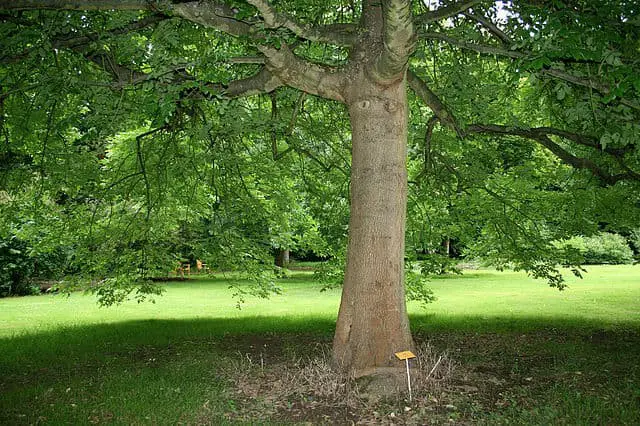
Oregon ash is a deciduous hardwood tree that thrives in the wetland regions of the western United States, playing a crucial role as a vital source of sustenance and shelter for various wildlife species. Its robust timber is highly prized for its heaviness, strength, and durability, making it an ideal choice for lumber, furniture, flooring, and other wood-based products.
Not only does Oregon ash boast striking dark green leaves and radiant white flowers, but it can also grow to remarkable heights of over 100 feet. As a keystone species in the western United States ecosystem, Oregon ash plays a vital part in supporting the local wildlife. Its value extends beyond its ecological significance, as humans also utilize its wood for various applications, including lumber, furniture, flooring, and other wood products.
Pumpkin Ash (Fraxinus profunda).

Pumpkin ash, a deciduous tree, can reach impressive heights of up to 50 feet. As a member of the olive family, it shares a kinship with other ashes like white ash and green ash. The name ‘pumpkin ash’ stems from the striking resemblance of its leaves to the popular gourd. Each leaf is compound, featuring multiple leaflets, and arranged in an opposite pattern on the stem. As autumn unfolds, these leaves transform into a vibrant yellow before surrendering to the tree’s seasonal shedding process.
Native to the eastern United States, pumpkin ash can be found flourishing in forests from Maine to Florida and as far west as Texas and Oklahoma. It thrives in moist soils but also displays remarkable resilience when faced with dry conditions. This adaptability has earned pumpkin ash a reputation as a sought-after tree for landscaping purposes, celebrated for its ornate foliage and stunning fall coloration.
Single-leaf ash (Fraxinus anomala).

The single-leaf ash tree, native to the western United States, stands out with its distinctive oval-shaped leaf, reminiscent of a solitary entity. The leaves themselves are dark green, boasting a glossy sheen that catches the eye. In the spring, delicate white flowers burst forth, preceding the production of small, hard seeds encased in leathery husks. The tree’s mature height is approximately 30 feet, with a sturdy trunk measuring around two feet in diameter.
Preferring sunny spots and well-drained soil conditions, this species thrives in environments that meet its needs. Its drought tolerance, rapid growth rate, and natural resistance to most pests and diseases make it a sought-after choice for landscapers, offering a low-maintenance yet visually appealing addition to any outdoor space.
Texas Ash (Fraxinus albicans).
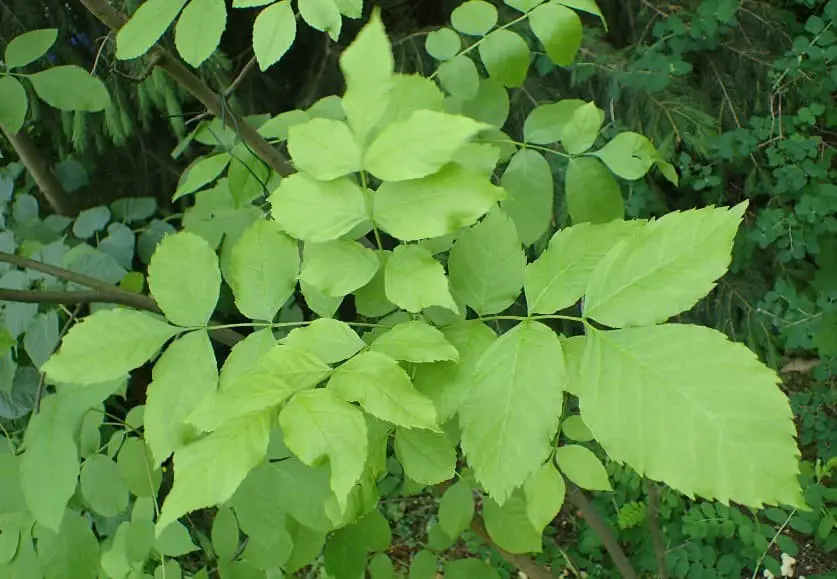
In the heart of central and eastern United States, as well as parts of Canada, the Texas ash tree thrives as a native species. This deciduous tree is distinguished by its ability to shed its leaves annually, giving way to new growth each year. The leaf structure is characterized by opposite, pinnately compound arrangements with seven to nine elliptical leaflets featuring serrated margins.
During the spring and summer, the leaves are a vibrant green, while the fall season brings a kaleidoscope of yellow, orange, and red hues as the tree prepares for dormancy. At maturity, the Texas ash can reach heights between 30 and 50 feet, sporting a short trunk and rounded crown. The bark is initially smooth and gray, gradually developing into rougher, scaly textures as the tree ages.
Its rapid growth rate and stunning fall coloration have solidified the Texas ash’s popularity in landscaping endeavors. Beyond its aesthetic appeal, the Texas ash offers significant value. Its sturdy wood is prized for construction, furniture making, and flooring due to its hardness, strength, and durability. Furthermore, this versatile tree has become a staple in urban forestry projects, providing shade, beauty, and environmental benefits by improving air quality and reducing noise pollution.
Velvet Ash (Fraxinus velutina).

The velvet ash, a species of tree belonging to the olive family, is endemic to North America. Its natural range spans from southern Ontario and Quebec in Canada, down to northern Florida in the United States, and westward to southeastern Arizona. This deciduous tree stands tall at 20-35 meters (66-115 feet) with a trunk diameter ranging from 60 centimeters (24 inches) to 1 meter (3.3 feet).
Characterized by its loss of leaves annually, the velvet ash’s foliage is composed of opposite, pinnately compound leaves measuring between 15 and 30 centimeters (0.59-11.81 inches) in length, featuring seven to thirteen leaflets each. These ovate to lanceolate-shaped leaflets showcase a unique velvety texture. As the tree matures, its bark transforms from smooth gray to fissured and scaly, while young twigs exhibit a hairless, velvety appearance.
Notably, this species is monoecious, bearing both male and female flowers on each individual tree, arranged in clusters of three to five small, greenish-white blooms. The fruit produced is a type of dry, one-seeded Samaras. Found in diverse habitats such as woodlands, floodplains, and hillsides, the velvet ash thrives in environments with varied soil types but prefers moist, well-drained soils for optimal growth.
White Ash (Fraxinus Americana).

Native to North America, the white ash tree is a deciduous hardwood species that can grow up to 150 feet tall, making it one of the tallest trees in the eastern United States. Its wide-spreading canopy provides exceptional shade due to its dense foliage. The smooth, light gray bark is a distinguishing feature of the tree.
The opposite, compound leaves of the white ash have seven to nine leaflets and are dark green in color, transforming into vibrant shades of yellow, orange, or red during autumn. The small, greenish-white flowers of the white ash give way to winged seeds, also known as samaras, which are a characteristic feature of this species.
Where to buy ash trees online?
When it comes to purchasing ash trees, Amazon is an excellent choice. The online retailer offers a vast selection of ash tree varieties and provides free shipping on orders over $25. Additionally, local nurseries are another great option for buying ash trees. These establishments typically carry multiple varieties, allowing you to compare options and make an informed decision. Furthermore, nursery staff can offer valuable guidance on which variety would best suit your landscape goals.
FAQs about Ash Trees
Why is it called an ash tree?
The ash tree’s classification lies within the genus Fraxinus and family Oleaceae. The term ‘ash’ itself has its roots in Old English, specifically the word æsc, which translates to ‘spear’. This etymological connection is likely a result of the ancient practice of utilizing ash wood for crafting spears and other weaponry.
What is special about the ash tree?
The ash tree’s unique characteristics make it a standout among its peers. Its adaptability to thrive in both wet and dry environments sets it apart from many other trees. Furthermore, the ash tree has developed a natural resistance to various diseases and pests, making it an attractive option for landscaping and gardening projects.
Additionally, the wood of the ash tree is renowned for its exceptional strength and durability, rendering it an ideal choice for crafting furniture and other woodworking creations. The leaves of the ash tree also hold significant value in traditional medicine, highlighting the importance of this remarkable tree in both practical and cultural contexts.
Where do ash trees grow best?
While it might seem counterintuitive, ash trees thrive in environments characterized by heavy rainfall and robust wind activity. Their remarkable resilience allows them to weather such challenging conditions with ease, making them well-suited for areas that experience frequent precipitation and gusts.
What is the fruit of the ash tree?
Native to North America, the ash tree is a deciduous species characterized by its distinctive fruit – a small, winged seed called a samara. This unique feature sets it apart from other trees in the region.
How fast does an ash tree grow?
While ash trees have the potential to grow a remarkable 24 inches annually, their typical annual increase in height averages around 12 inches. Interestingly, the rate at which these trees sprout upwards has a direct impact on their lifespan; the faster they grow, the shorter their life expectancy tends to be.
Should I plant an ash tree?
While it’s not always easy to provide a straightforward answer, I’d like to outline some key factors that influence whether planting an ash tree is a good idea. Chief among these are your location, local climate, and ability to safeguard the tree from pests and diseases. With that in mind, my general advice would be to exercise caution when considering planting ash trees, unless you’re confident in your capacity to provide adequate protection.
If you do decide to proceed with planting an ash tree, it’s essential to select a disease-resistant variety and remain vigilant for any signs of distress or potential issues.
Are ash trees poisonous?
While it may seem counterintuitive, ash trees are not inherently toxic to humans or animals. Nonetheless, the leaves and seeds of these trees do possess properties that can lead to discomfort when ingested in excessive amounts. Specifically, they have the potential to cause skin reactions and gastrointestinal disturbances.
How close should an ash tree be to a house?
Ash trees, part of the Fraxinus spp. family, are notable for their impressive height of up to 100 feet when mature. Their stately appearance and adaptability to varied growing conditions make them a popular choice for landscaping. However, before planting one near your residence, it’s essential to consider several factors.
One crucial consideration is the tree’s mature size.
Ash trees can grow quite large, with sprawling roots that require sufficient space to prevent damage to your home’s foundation or underground plumbing. Additionally, branches may scrape against your siding or windows if the tree is planted too close.
Another factor to consider is the tree’s propensity for shedding limbs. During extreme weather conditions, ash trees are known to drop branches, posing a risk of serious property damage if they fall too close to your house.
To mitigate these risks, it’s crucial to provide sufficient space when planting an ash tree near your home. A minimum distance of 20 feet from the structure is recommended, allowing the tree to thrive without compromising your property’s integrity.
Conclusion
While there are numerous species of ash trees, the white ash and green ash are among the most prevalent in North America. Both varieties are remarkably versatile, making them suitable for a wide range of applications. Whether you’re seeking a shade tree to adorn your yard or desire the wood for crafting furniture or other projects, ash is an excellent choice.
However, it’s essential to verify with local nurseries or extension offices that the specific type of ash tree you’re considering is well-suited to your region’s climate and growing conditions.
Related Posts
Discovering the vast array of plant varieties available online can be overwhelming. From apple trees to evergreens, there’s an incredible range of options for gardeners and tree enthusiasts alike. But did you know that becoming an arborist can be a fulfilling career path? Our guide will walk you through the steps necessary to become a certified tree care professional.
Trees have a profound impact on any property – not only do they provide shade and beauty, but they also play a crucial role in supporting local ecosystems. However, sometimes trees can negatively affect a home’s appeal. Knowing when to remove them is essential. Meanwhile, for those looking to add some tropical flair to their garden, the lady palm (Rhapis excelsa) is an excellent choice. But what about growing organic blueberry plants?
With the right care and attention, these delicious fruits can thrive in your own backyard.


